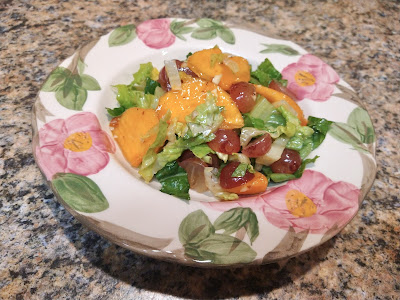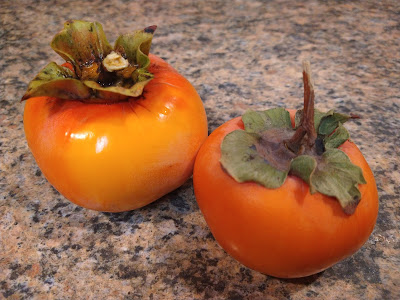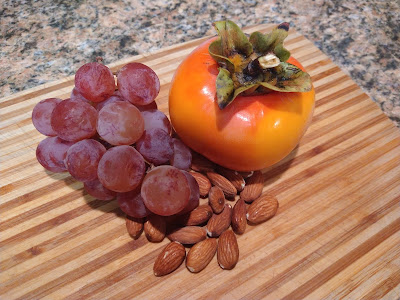
Recipe: Persimmon-red grape salad with white-wine vinaigrette

a weekday meal or holiday gathering. (Photos: Debbie Arrington) |
With jewel-like colors, this fruity combination will brighten late-fall or early winter meals. It’s simple enough for every day, but attractive (and tasty) enough for upcoming holiday get-togethers.
The main ingredients are few: Fuyu persimmon, red grapes, almonds and romaine lettuce.
It’s the white wine vinaigrette that brings them all together and accents their flavors. Using wine instead of vinegar softens the vinaigrette’s edges and complements the fruit’s sweetness. (It also keeps the persimmon its beautiful color.) I used mandarin orange syrup in the vinaigrette for another fruity note but a little sugar works as well.
Fresh Fuyu persimmons – the squat and crunchy kind – look like orange tomatoes. Like tomatoes, crisp Fuyus make a wonderful addition to traditional green salads. (Save the mushy ones for cookies.)
Persimmon-red grape salad
Makes 4 servings
Ingredients:

1 large Fuyu persimmon, peeled and sliced
1 cup large red grapes, washed and halved
2 tablespoons almonds, chopped
3 cups romaine lettuce, shredded
Vinaigrette:
2 tablespoons extra virgin olive oil
2 tablespoons white wine
1 teaspoon mandarin orange syrup or ½ teaspoon sugar
½ teaspoon seasoning salt
Several grinds of black pepper

|
Instructions:
In a large bowl, combine sliced persimmon, grapes and almonds.
Make vinaigrette. Combine all ingredients in a shaker jar; cover and shake. (Or whisk ingredients together in a small bowl.)
Pour vinaigrette over fruit mixture. Toss lightly to coat.
Add lettuce. Toss just before serving.
Comments
0 comments have been posted.Sacramento Digs Gardening to your inbox.
Sites We Like
Garden Checklist for week of April 21
This week there’s plenty to keep gardeners busy. With no rain in the immediate forecast, remember to irrigate any new transplants.
* Weed, weed, weed! Get them before they flower and go to seed.
* April is the last chance to plant citrus trees such as dwarf orange, lemon and kumquat. These trees also look good in landscaping and provide fresh fruit in winter.
* Smell orange blossoms? Feed citrus trees with a low dose of balanced fertilizer (such as 10-10-10) during bloom to help set fruit. Keep an eye out for ants.
* Apply slow-release fertilizer to the lawn.
* Thoroughly clean debris from the bottom of outdoor ponds or fountains.
* Spring brings a flush of rapid growth, and that means your garden is really hungry. Feed shrubs and trees with a slow-release fertilizer. Or mulch with a 1-inch layer of compost.
* Azaleas and camellias looking a little yellow? If leaves are turning yellow between the veins, give them a boost with chelated iron.
* Trim dead flowers but not leaves from spring-flowering bulbs such as daffodils and tulips. Those leaves gather energy to create next year's flowers. Also, give the bulbs a fertilizer boost after bloom.
* Pinch chrysanthemums back to 12 inches for fall flowers. Cut old stems to the ground.
* Mulch around plants to conserve moisture and control weeds.
* From seed, plant beans, beets, cantaloupes, carrots, corn, cucumbers, melons, radishes and squash.
* Plant onion sets.
* In the flower garden, plant seeds for asters, cosmos, celosia, marigolds, salvia, sunflowers and zinnias.
* Transplant petunias, zinnias, geraniums and other summer bloomers.
* Plant perennials and dahlia tubers for summer bloom.
* Mid to late April is about the last chance to plant summer bulbs, such as gladiolus and tuberous begonias.
* Transplant lettuce seedlings. Choose varieties that mature quickly such as loose leaf.